Progress made on the new museum at Kings Mountain National Military Park, South Carolina, is worthy of record, and the fact that the Service possesses a Ferguson rifle to put into that museum constitutes special note within the record. To the average park visitor "Ferguson rifle" means little or nothing, but to the student of military history mention of that British weapon kindles a flame of interest. The story of how the Ferguson rifle was pitted against the Kentucky rifle at Kings Mountain is significant in this day of rearmament.
Maj. Patrick Ferguson was born in 1744, the son of a Scottish jurist, James Ferguson of Pitfour. At an early age he became an officer in the Royal North British Dragoons, and by the time the American colonists revolted against British rule he had distinguished himself in service with the Scotch militia and as an expeditionist during the Carib insurrection in the West Indies. In 1776 he demonstrated to British Government officials a weapon of his own invention, "a rifle gun on a new construction which astonished all beholders."
The remarkable feature of the gun is its perpendicular breech plug equipped with a screw device so as to make it possible to lower it by a revolution of the trigger guard which serves as a handle. When the breech plug is lowered, an opening is left in the top of the barrel at the breech. A spherical bullet dropped into this opening with the muzzle of the gun held downward rolls forward through the chamber where it is stopped by the lands of the rifling. A charge of powder then poured into the opening fills the chamber behind the bullet, whereupon one revolution of the trigger guard closes the breech and the weapon is ready for priming and firing. Major Ferguson demonstrated that six aimed shots per minute could be fired with an accuracy creditable to any rifle. Advancing riflemen could fire four aimed shots per minute; reloading being possible while the marksman was running. Another great advantage of the Ferguson rifle was found in the fact that it could be loaded while the marksman was reclining—something quite impossible with the American rifle. A patent was granted for the Ferguson invention on December 2, 1776, and the weapon became the first breechloader used by organized troops of any country.
On September 11, 1777, Major Ferguson commanded the small unit of picked riflemen of the British Army who covered the advance of Knyphauser and his German mercenaries at Brandywine. An American who knew nothing of breechloading rifles, but who was possessed of the old dependable Kentucky rifle, put a bullet into Ferguson's right arm, shattering the elbow. The major's arm was useless thereafter and while he was recuperating Sir William Howe jealously took advantage of his disability, disbanded Ferguson's riflemen, and put into storage the superior rifles which they had carried. This did not terminate the service of Ferguson, nor did it relegate his rifle to the discard. His command was restored, and he again took the field with his handful of riflemen. At Stony Point, N. Y., and Little Egg Harbor, N. J., he came out on top in the fighting with American privateers and the famous Pulaski Legion. Had Great Britain manufactured more of the Ferguson rifles, perhaps he would have gained further victories.
Sir Henry Clinton's expedition of 1779 against Charleston, S. C., found Ferguson and a comparatively few of his rifles active in the depredations of several thousand Tories organized to terrorize the rebellious colonists of the Carolinas. They invaded the interior and operated on the very western border of the Carolinas. For 5 months he held sway over the upcountry, enticing or intimidating the young men of the region to enlist under the British flag. The local militia so formed in the wild back country were drilled by him in the ways of the British Army, and all other inhabitants, so far as possible, were pledged to faithful Royal service. The patriots of the interior settlements lay helpless. Any Carolinian found in arms against the King might be—and many were—hanged for treason. Finally, a British proclamation was issued requiring all inhabitants to take active part on the royalist side, which but served to bring about a notable uprising of the Whigs who, throughout the summer of 1780, engaged in fierce guerilla warfare against the organized Tories.
Not only did the sparsely populated settlements on the headwaters of the Catawba, Broad, and Pacolet Rivers contribute to the force that opposed Ferguson, but the over-mountain settlements on the Watauga and Holston likewise sent their backwoodsmen, all of whom were well experienced in Indian warfare. The routes followed by these parties on their way to the Kings Mountain rendezvous cross the present Blue Ridge National Parkway in a number of places.
The unmerciful treatment of Buford's patriots at the hands of Tarleton had engendered savage fury on the part of the Whigs which was as bitterly reciprocated by the Tories. Utter refusal of quarter was usual in many battles. In the Carolinas, hand-to-hand encounters were common, and the contest became a war of ruthless extermination. General Greene, writing of this condition, said: "The animosity between the Whigs and Tories renders their situation truly deplorable. . . . The Whigs seem determined to extirpate the Tories, and the Tories the Whigs . . . If a stop cannot be put to these massacres, the country will be depopulated in a few months more, as neither Whig nor Tory can live."
In September 1780, while this spirit of hatred was at its height, the regiments of backwoods patriots, who were to go down in history as "Kings Mountain Men," rendezvoused at South Mountain north of Gilbert Town and determined to set upon Ferguson and his command, then believed to be in Gilbert Town. The followers of the Whig border leaders, Campbell, Shelby, Sevier, Cleveland, Lacey, Williams, McDowell, Hambright, Hawthorne, Brandon, Chronicle, and Hammond, descended upon Gilbert Town on October 4 only to find that the Tories, apprised of the planned attack, had evacuated that place; Ferguson was in full retreat in an attempt to evade an engagement. His goal was Charlotte and the safety of the British forces there stationed under Cornwallis. On October 6, Ferguson was attracted from his line of march to the commanding eminence, Kings Mountain, known at that time by the famous name that we apply today. His 1,100 loyalists went into camp on these heights, and Ferguson declared that "he was on Kings Mountain, that he was King of that mountain, and God Almighty could not drive him from it." He took none of the ordinary military precautions of forming breastworks, but merely placed his baggage wagons along the northeastern part of the mountain to give some slight appearance of protection in the neighborhood of his headquarters.
The united backwoodsmen, led by Campbell, had pursued the fleeing Tories from Gilbert Town. Spies sent forward obtained accurate information on the numbers and intentions of the Tories. It became evident to the Whig leaders that, if they were to overtake their quarry before reinforcements sent by Cornwallis might join them, a more speedy pursuit would be necessary. Accordingly, on the night of October 5, the best men, horses, and equipment were selected for a forced march. About 900 picked horsemen, all well armed with the Kentucky rifle, traveled by way of Cowpens, S. C., marching throughout the rainy night of October 6, crossed the swollen Broad River at Cherokee Ford, and on the afternoon of October 7 came upon the Loyalists on their supposed stronghold.
The story of the battle which ensued is one of the thrilling chapters in our history. The Whigs surrounded the mountain and, in spite of a few bayonet charges made by the Tories, pressed up the slopes and poured into the Loyalist lines such deadly fire from the long rifles that in less than an hour 225 had been killed, 163 wounded, and 716 made prisoners. Major Ferguson fell with eight bullets in his body. The Whigs lost 28 killed and 62 wounded.
Probably no other battle in the Revolution was so picturesque or so furiously fought as that at Kings Mountain. The very mountain thundered. Not a regular soldier was in the American ranks. Every man there was actuated by a spirit of democracy. They fought under leaders of their own choosing for the right to live in a land governed by men of their own choice.
With the death of Ferguson, the rifles of his invention, with which probably 150 of his men were armed, disappeared. Some were broken in the fight and others were carried off by the victors. One given by Ferguson to his companion, De Peyster, is today an heirloom in the family of the latter's descendants in New York City. It was exhibited by the United States Government at the World's Fair at Chicago in 1893. A very few are to be found in museum collections in this country and in England. The one possessed by the National Park Service was obtained from a dealer in England through the vigilance of members of the staff of the Colonial National Historical Park, Virginia, and is now exhibited in the museum at Kings Mountain National Military Park, South Carolina.
The Kings Mountain museum tells the story of the Revolutionary backwoodsman and his place in the scheme of Americanism. Here also is presented the story of the cultural, social, and economic background of the Kings Mountain patriots, as well as the details of the battle and its effect on the Revolution as a whole. Here lies the rare opportunity to preserve for all time significant relics of Colonial and Revolutionary days and at the same time interpret for a multitude of visitors the basic elements in the story of the old frontier—a story which affected most of the Nation during the century that followed the Revolution.
Our interest here will turn to those intriguing reminders of how our Colonial ancestors lived—their houses, their tools and implements, their furniture, their books, and their guns. Because of the significance of the American rifle in the battle of Kings Mountain, it must be a feature of any Kings Mountain exhibit. In the Carolinas it was as much a part of each patriot as was his good right arm.
Light in weight, graceful in line, economical in consumption of powder and lead, fatally precise, and distinctly American, it was for 100 years the great arbitrator that settled all differences throughout the American wilderness. George Washington, while a surveyor in the back country, as scout and diplomat on his march into the Ohio country, and while with his Virginians on Braddock's fatal expedition, had formed the acquaintance of the hunters, Indian fighters, and pioneers of the Alleghanies—riflemen all. These men were drawn upon in 1775 to form the first units of the United States Army, 10 companies of "expert riflemen." The British, in an attempt to compete with American accuracy of fire, cried for Jager, German huntsmen armed with rifles, and begged that they might be included in the contingents of German troops.
| German Jager rifle, used in America during the Revolution, above; as compared with the Kentucky rifle of the Revolutionary period, below. |
From the numerous written comments on the American rifle and riflemen made by British leaders, it would be possible to quote at length regarding the effect of American rifle fire upon British morale and casualty lists. We may call attention again to the statistics on the Kings Mountain dead: British, 225; American, 28. Draper records that 20 dead Tories were found behind certain protruding rocks on the crest of the hill, and that each victim was marked by a bullet hole in his forehead. Col. George Hanger, British officer with Tarleton in South Carolina, provides the following observation on the precision of American rifle fire:
I never in my life saw better rifles (or men who shot better) than those made in America; they are chiefly made in Lancaster, and two or three neighboring towns in that vicinity, in Pennsylvania. The barrels weigh about six pounds two or three ounces, and carry a ball no larger than thirty-six to the pound; at least I never saw one of the larger caliber, and I have seen many hundreds and hundreds. I am not going to relate anything respecting the American war; but to mention one instance, as a proof of most excellent skill of an American rifleman. If any man shew me an instance of better shooting, I will stand corrected.
Colonel, now General Tartleton, and myself, were standing a few yards out of a wood, observing the situation of a part of the enemy which we intended to attack. There was a rivulet in the enemy's front, and a mill on it, to which we stood directly with our horses' heads fronting, observing their motions. It was an absolute plain field between us and the mill; not so much as a single bush on it. Our orderly-bugle stood behind us, about 3 yards, but with his horse's side to our horses' tails. A rifleman passed over the mill-dam, evidently observing two officers, and laid himself down on his belly; for, in such positions, they always lie, to take a good shot at a long distance. He took a deliberate and cool shot at my friend, at me, and the bugle-horn man. (I have passed several times over this ground, and ever observed it with the greatest attention; and I can positively assert that the distance he fired from, at us, was full four hundred yards.)
Now, observe how well this fellow shot. It was in the month of August, and not a breath of wind was stirring. Colonel Tartleton's horse and mine, I am certain, were not anything like two feet apart; for we were in close consultation, how we should attack with our troops, which laid 300 yards in the wood, and could not be perceived by the enemy. A rifle-ball passed between him and me; looking directly to the mill, I observed the flash of the powder. I said to my friend, "I think we had better move, or we shall have two or three of these gentlemen, shortly, amusing themselves at our expence. The words were hardly out of my mouth, when the bugle horn man, behind us, and directly central, jumped off his horse, and said, "Sir, my horse is shot." The horse staggered, fell down, and died. He was shot directly behind the foreleg, near to the heart, at least where the great blood-vessels lie, which lead to the heart. He took the saddle and bridle off, went into the woods, and got another horse. We had a number of spare horses, led by negro lads.
The rifle had been introduced into America about 1700 when there was considerable immigration into Pennsylvania from Switzerland and Austria, the only part of the world at that time where it was in use. It was then short, heavy, clumsy, and little more accurate than the musket. From this arm the American gunsmiths evolved the long, slender, small-bore gun (about 36 balls to the pound) which by 1750 had reached the same state of development that characterized it at the time of the Revolution. The German Jager rifle brought to America during the Revolution was by no means the equal of the American piece. It was short-barreled and took a ball of 19 to the pound. With its large ball and small powder charge its recoil was heavy and its accurate range but little greater than that of the smoothbore musket. It was the same gun that had been introduced into America in 1700.
The standard military firearm of the Revolutionary period was the flintrock musket weighing about 11 pounds. Its caliber was 11 gauge, that is, it would take a lead ball of 11 to the pound. At 100 yards a good marksman might make 40 percent of hits on a target the size of a man standing. The musket ball, fitting loosely in the barrel, could be loaded quickly. The fact that the military musket always was equipped with a bayonet made it the dependable weapon for all close fighting. As was so convincingly shown on the occasions of the futile bayonet charges of Ferguson's regulars on Kings Mountain, however, the bayonet was not effective if enemy lines did not stand to take the punishment of hand-to-hand fighting.
Each Whig on Kings Mountain had been told to act as his own captain, to yield as he found it necessary, and to take every advantage that was presented. In short, the patriots followed the Indian mode of attack, using the splendid cover that the timber about the mountain afforded, and selecting a definite human target for every ball fired. Splendid leadership and command were exercised by the Whig officers to make for concerted action every time a crisis arose. This coordination, plus the Kentucky rifle and the "individual power of woodcraft, marksmanship, and sportsmanship" of each participant in the American forces, overcame all the military training and discipline which had been injected into his Tory troops by Ferguson.
By C. P. Russell, Supervisor of Interpretation, Washington
*From The Regional Review, National Park Service, Region One, Richmond, Va., Vol. V, No. 1, July 1940, pp. 15-21.
A Ferguson by David Crisilli has been posted on the blog.
A Ferguson by David Crisilli has been posted on the blog.







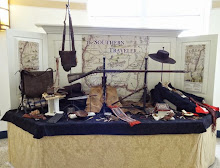





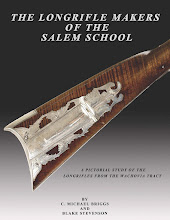

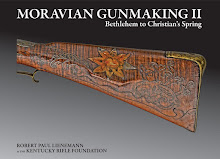


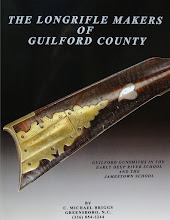

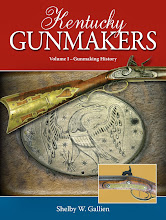









I am curious to know where the author derives his notion that there were 150 of Ferguson's rifles in British hands at King's Mountain. There is actually no evidence of their presence in the south, save for the possibility of the one given to De Peyster. There is no record of Ferguson Rifles in Military stores in the South at the time, nor with regiments. In fact, the only place Ferguson's rifles show up, are in storage in New York City at this time. This myth needs to be laid to rest once and for all.
ReplyDeleteBest Regards.
JRM
Actually take a look at http://www.everyinsultandindignity.com for archeological and historical record evidence of the Ferguson Ordnance Rifle at the Battle of Kings Mountain. If they were all put into storage in NY, why can EVERY surviving Ferguson Ordnance Rifle in the US be traced to Union Soldiers who served in the South?
ReplyDeleteFerguson did not invent the action. It was common in, perhaps the most common form of rifle in England for over a generation by the time he made a couple of improvements and it got called a Ferguson.
ReplyDeleteI lived for a time in York, SC, a bicycle ride from King's Mountain. I spent a lot of time there. I have a Ferguson Rifle and know several people who also own them, built of parts sets from the Rifle Shoppe.
ReplyDeleteFerguson contracted for about 200 rifles with three gunsmith firms capable of machining the Morse Taper bolt. The rifles were supposed to follow his deployment to America, but extant letters written by him indicate that a significant number of the contract never arrived. Ferguson was wounded at the Battle of Brandywine and his 100 man unit was dispanded and the rifles, except for a few owned by officers, were collected and stored in a warehouse in Philadelphia, which subsequently burned. Aracheological evidence at King's Mountain suggest that several Fergusons were present, probably belonging to Ferguson's officers. They were undoubtedly captured at the surrender as souvenirs. These rifles are delicate and prone to breaking at the wrist and most show repair there. The are finnicky to load and shoot with the tallow lube having to be as just the right consistency for the rifle to function. The fouling without high grade sporting powder quickly freezes the bolt and turns the rifle into a muzzleloader. (personal experience!). The .615 caliber ball was used in some pistols but not generally available beyond that. I suspect that most were eventually abandoned as impractical by the people who had them. I have located about twenty of these rifles both Ordinace Pattern and Sporting rifles offered by the East Inda Company. They were popular hunting weapons for a brief period of time.
The breech is a modification of the earlier Chaumet design used in some battles in the Carribean.